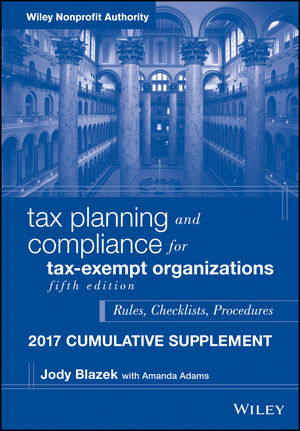
Tax Planning and Compliance for Tax-Exempt Organizations
John Wiley & Sons Inc (Verlag)
978-1-119-35211-2 (ISBN)
- Titel erscheint in neuer Auflage
- Artikel merken
The essential time-saving guide to the latest in nonprofit tax rules, regulations, and procedures Tax rules and regulations change annually, and nonprofit organizations know that staying compliant means staying up to date. But wading through tax code is less than helpful in the field, whereas the clear, practically oriented instruction inside provides the quick reference accountants, lawyers, and executives need. In the latest edition of Tax Planning and Compliance for Tax-Exempt Organizations, you'll find straightforward information on changing Unrelated Business Income (UBI) rules, joint ventures, sponsorships, deductions against UBI, preparation of IRS forms, and more. Nonprofit organizations including health and welfare organizations, colleges and universities, private foundations, churches, libraries, museums, cultural institutions, and other smaller groups contend daily with the possibility of losing their tax-exempt status. From qualifying and applying for that status, to maintaining and managing it, every nonprofit organization must plan and monitor ongoing procedures, activities, and forms to comply with federal, state, and local regulations.
* Access easy checklists for reporting, compliance, eligibility, and more * Examine sample bylaws, applications, and forms * Utilize comparison charts and other visual aids for easy reference * Review bullet lists that compare what is and what is not acceptable Tax Planning and Compliance for Tax-Exempt Organizations is an indispensable guide to navigating the complex maze of nonprofit tax rules and regulations.
JODY BLAZEK ( Houston TX) is a partner in Blazek & Vetterling LLP, a CPA firm focusing on tax and financial planning for exempt organizations and the individuals who create, fund, and work with them. BV serves over 400 nonprofit organizations providing financial reports and tax compliance and planning services. She is the author of six books in the Wiley Nonprofit Series: Revised Form 990; Nonprofit Financial Planning Made Easy; IRS Form 1023 Preparation Guide; Tax Planning and Compliance for Tax-Exempt Organizations, 4e; Private Foundations: Tax Law and Compliance, 3e; and The Legal Answer Book for Private Foundations, the latter two volumes co-authored with Bruce R. Hopkins. Blazek serves on the Panel of the Nonprofit Sector, Transparency and Financial Accountability Work Group. She is past Chair of the Tax-Exempt Organizations Resource Panel and a member of Form 1023 and 990 Revision Task Forces for the American Institute of Certified Public Accountants.
Preface ix PART I QUALIFICATIONS OF TAX-EXEMPT ORGANIZATIONS 1 CHAPTER 2 Qualifying Under IRC 501(c)(3) 3 * 2.2 Operational Test 3 *CHAPTER 3 Churches 5 3.2 Churches 5 CHAPTER 4 Charitable Organizations 7 4.2 Promotion of Social Welfare 7 * 4.3 Lessening Burdens of Government 7 4.6 Promotion of Health 8 CHAPTER 5 Educational, Scientific, and Literary Purposes, and Prevention of Cruelty to Children and Animals 19 5.1 Educational Purposes 19 5.4 Testing for Public Safety 20 CHAPTER 6 Civic Leagues and Local Associations of Employees: 501(c)(4) 21 6.1 Comparison of (c)(3) and (c)(4) Organizations 21 * 6.2 Qualifying and Nonqualifying Civic Organizations 22 * 6.4 Neighborhood and Homeowner s Associations 24 6.5 Disclosures of Nondeductibility 24 CHAPTER 8 Business Leagues: 501(c)(6) 25 8.2 Meaning of Common Business Interest 25 8.3 Line of Business 25 * 8.4 Rendering Services for Members 26 CHAPTER 9 Social Clubs: 501(c)(7) 27 * 9.1 Organizational Requirements and Characteristics 27 9.4 Revenue Tests 28 CHAPTER 10 Instrumentalities of Government and Title-Holding Organizations 29 10.2 Governmental Units 29 * 10.3 Qualifying for 501(c)(3) Status 29 CHAPTER 11 Public Charities 33 11.1 Distinction between Public and Private Charities 33 * 11.2 Inherently Public Activity and Broad Public Support 509(a)(1) 33 11.6 Supporting Organizations 509(a)(3) 36 PART II STANDARDS FOR PRIVATE FOUNDATIONS 47 CHAPTER 12 Private Foundations General Concepts 49 12.2 Special Rules Pertaining to Private Foundations 49 12.4 Termination of Private Foundation Status 50 CHAPTER 13 Excise Tax Based on Investment Income: IRC 4940 55 * 13.2 Capital Gains 55 CHAPTER 14 Self-Dealing: IRC 4941 57 14.1 Definition of Self-Dealing 57 * 14.2 Sale, Exchange, or Lease of Property 58 14.3 Loans 60 14.4 Compensation 61 14.5 Transactions That Benefit Disqualified Persons 62 * 14.7 Sharing Space, People, and Expenses 63 * 14.8 Indirect Deals 64 14.9 Property Held by Fiduciaries 65 14.10 Issues Once Self-Dealing Occurs 65 CHAPTER 15 Minimum Distribution Requirements: IRC 4942 67 15.1 Assets Used to Calculate Minimum Investment Return 67 15.2 Measuring Fair Market Value 68 * 15.4 Qualifying Distributions 68 15.6 Satisfying the Distribution Test 77 CHAPTER 16 Excess Business Holdings and Jeopardizing Investments: IRC 4943 and 4944 81 16.1 Excess Business Holdings 81 16.2 Jeopardizing Investments 83 16.3 Program-Related Investments 84 16.4 Penalty Taxes 86 CHAPTER 17 Taxable Expenditures: IRC 4945 87 17.1 Lobbying 87 * 17.3 Grants to Individuals 88 * 17.4 Grants to Public Charities 91 * 17.5 Grants to Foreign Organizations 94 17.8 Excise Tax Payable 126 PART III OBTAINING AND MAINTAINING TAX-EXEMPT STATUS 127 CHAPTER 18 IRS Filings, Procedures, and Policies 129 * 18.1 Determination Process 129 * 18.2 Annual Filing of Forms 990 141 18.3 Reporting Organizational Changes to the IRS 148 18.4 Weathering an IRS Examination 149 * 18.5 When an Organization Loses its Tax-Exempt Status 150 CHAPTER 19 Maintaining Exempt Status 169 19.1 Checklists 169 CHAPTER 20 Private Inurement and Intermediate Sanctions 175 20.1 Defining Inurement 176 20.2 Salaries and Other Compensation 177 * 20.4 Finding Salary Statistics 177 20.8 Services Rendered for Individuals 178 20.10 Intermediate Sanctions 178 CHAPTER 21 Unrelated Business Income 179 21.1 IRS Scrutiny of Unrelated Business Income 179 21.4 Definition of Trade or Business 180 21.5 What Is Unrelated Business Income? 180 * 21.7 Substantially Related 180 * 21.8 Unrelated Activities 182 21.10 Income Modifications 185 * 21.11 Calculating and Minimizing Taxable Income 186 21.12 Debt-Financed Property 187 21.13 Museums 188 21.15 Publishing 188 CHAPTER 23 Electioneering and Lobbying 189 23.1 Election Campaign Involvement 189 23.2 Voter Education versus Candidate Promotion 189 CHAPTER 24 Deductibility and Disclosures 191 * 24.1 Overview of Deductibility 191 24.2 Substantiation and Quid Pro Quo Rules 195 CHAPTER 25 Employment Taxes 197 25.2 Ministers 197 Index 201
| Erscheinungsdatum | 07.04.2017 |
|---|---|
| Reihe/Serie | Wiley Nonprofit Authority |
| Co-Autor | Amanda Adams |
| Verlagsort | New York |
| Sprache | englisch |
| Maße | 178 x 252 mm |
| Gewicht | 358 g |
| Themenwelt | Recht / Steuern ► EU / Internationales Recht |
| Recht / Steuern ► Steuern / Steuerrecht | |
| Sozialwissenschaften ► Politik / Verwaltung ► Staat / Verwaltung | |
| Wirtschaft ► Betriebswirtschaft / Management | |
| Wirtschaft ► Volkswirtschaftslehre ► Wirtschaftspolitik | |
| ISBN-10 | 1-119-35211-8 / 1119352118 |
| ISBN-13 | 978-1-119-35211-2 / 9781119352112 |
| Zustand | Neuware |
| Haben Sie eine Frage zum Produkt? |
aus dem Bereich



